Undergraduate Expo 2008
1st Place Award Undergraduate Research Presentation
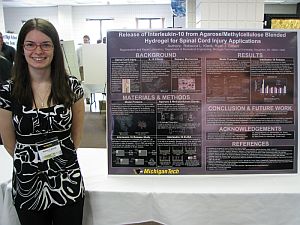 |
| Release of Interleukin-10 from Agarose/Methylcellulose Blended Hydrogel for Spinal Cord Injury Applications |
| Department: |
Biomedical Engineering |
| Advisors: |
Dr. Ryan Gilbert, Biomedical Engineering |
| Sponsors |
Summer Undergraduate Research Fellowship (SURF) |
| Student Researchers |
Rebecca Klank, Biomedical Engineering |
|
Abstract
After initial spinal cord injury (SCI), a secondary, inflammatory injury response leads to further neuronal death. Thus, therapies are being developed to attenuate inflammation following SCI to spare neurons and improve regenerative outcomes. Interleukin-10 (IL-10) is a cytokine that modulates the inflammatory response. In this study, IL-10 was incorporated into a hydrogel blend consisting of agarose and methylcellulose and the release into solution was characterized.Bioactivity and release rate of the IL-10 was confirmed using an enzyme linked immunosorbent assay. IL-10 was released from the hydrogel over several days. These data suggest that IL-10 can be loaded into a hydrogel, and be delivered locally over a sustained period of time without altering the activity of the cytokine. Therefore, this hydrogel, loaded with IL-10, has potential to reduce inflammation over a sustained period of time and reduce secondary injury effects in the damaged spinal cord.
3rd Place Award Undergraduate Research Presentation
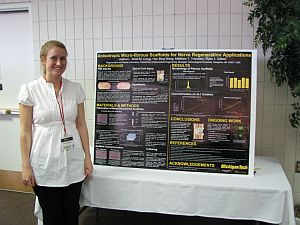 |
Anisotropic Micro-fibrous Scaffolds for Nerve Regeneration Applications |
Department: |
Biomedical Engineering |
Advisors: |
Dr. Ryan Gilbert, Department of Biomedical Engineering |
Student Researchers |
Jared Cregg, Sarah McIntyre, and Matthew Trombley, Biomedical Engineering; Han Bing Wang, Chemical Engineering |
|
Abstract
Following spinal cord and peripheral nerve injury, regenerating axons encounter natural environments that are not suitable for growth. Systems that modify these environments to allow axonal regeneration are of interest for promoting functional recovery after injury. In this study, a novel material that incorporates physical and chemical guidance cues for directed axonal regeneration was developed by adsorbing a gradient of the neurostimulatory protein laminin-1 onto aligned micro-fiber scaffolds. Sensory neurons from chick embryo were isolated and cultured on scaffolds to evaluate material performance. We suggest that these scaffolds may act as a growth permissive substrate and provide axons with necessary guidance cues for regeneration following injury.
|
Novel Silica Phosphate Sol-Gel Glasses as a Model System to Study Cellular Response to Dynamic Mineralization |
Department: |
Biomedical Engineering |
Advisors: |
Dr. Rupak M Rajachar, Biomedical Engineering |
Student Researchers |
Samantha Jang-Stewart, Logan Janka, and Kyle Tourni, Biomedical Engineering |
|
Abstract
Vascular calcification is highly correlated with cardiovascular disease mortality, especially in cases of end-stage renal disease and diabetes. Extensive studies have determined that pathological calcification is a highly regulated process. Developing synthetic biomaterials as instructive models of extra-cellular microenvironment can be a significant tool towards more physiologically relevant in vitro model systems. Therefore, the successful development of novel silica phosphate sol-gel glasses will aid our ability to address fundamental effects of dynamic processes on the regulation of pathological mineralization and ultimately to tailored cell instructive materials to control these processes.
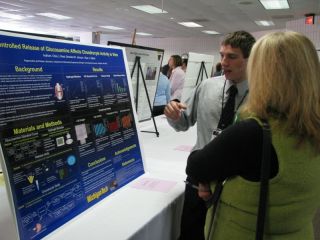 |
Controlled Release of Glucosamine Affects Chondrocyte Activity in Vitro |
Department: |
Biomedical Engineering |
Advisors: |
Dr. Ryan Gilbert Biomedical Engineering |
Student Researchers |
Brandon Johnson, Biomedical Engineering |
|
Abstract
Osteoarthritis (OA) is a disease which effects many millions of people in the U.S alone. OA is characterized by the degradation of articular cartilage in joints, leading to pain and in extreme cases physical impairment. A microgravity environment seen during forthcoming prolonged space travel missions can also create osteoarthritic conditions. Current treatments vary yet do not entirely eliminate the symptoms of this disease. Glucosamine is a commonly used treatment of OA however in its current form its effectiveness is limited. In this study a hydrogel, developed from a blend of agarose and methylcellulose, was loaded with glucosamine. We determined the effect of a controlled release of glucosamine on resident chondrocytes in vitro. Additionally, we categorized both the compressive modulus and release profile of the gel. The results of the study suggest that the investigated system may be an effective tissue engineering scaffold to house chondrocytes and release glucosamine to chondrocytes.
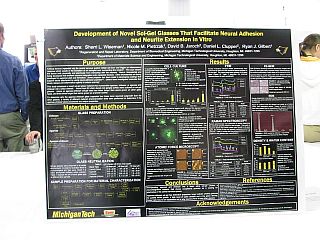 |
Novel silica phosphate sol-gel glasses as a model system to study cellular response to dynamic mineralization |
Department: |
Biomedical Engineering |
Advisors: |
Dr. Rupak M Rajachar, Biomedical Engineering |
Student Researchers |
Samantha Jang-Stewart, Logan Janka, and Kyle Tourni, Biomedical Engineering |
|
Abstract
Vascular calcification is highly correlated with cardiovascular disease mortality, especially in cases of end-stage renal disease and diabetes. Extensive studies have determined that pathological calcification is a highly regulated process. Developing synthetic biomaterials as instructive models of extra-cellular microenvironment can be a significant tool towards more physiologically relevant in vitro model systems. Therefore, the successful development of novel silica phosphate sol-gel glasses will aid our ability to address fundamental effects of dynamic processes on the regulation of pathological mineralization and ultimately to tailored cell instructive materials to control these processes.
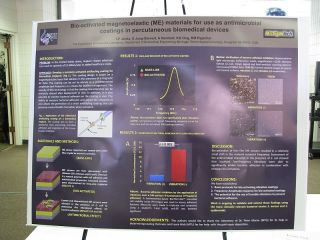 |
Characterization of Chitosan-coated Magnetoelastic Materials for Use in Percutaneous Implants |
Department: |
Biomedical Engineering |
Advisors: |
Dr. Rupak M Rajachar, Biomedical Engineering |
Student Researchers |
Logan Janka, Biomedical Engineering and Mechanical Engineering; and Natalie Hartman, Biomedical Engineering |
|
Abstract
In this work, we are developing bioactively coated vibrational magnetoelastic (ME) materialsforuse as aremotely activated tunable coating .These coatings promote the inhibition of bacterial adhesion at the tissue-implant interface . ME sensors are currently used as an in situ method of measuring biological processes .This study developed an ME antimicrobial coating and characterized the response towards modulated sensor frequency-amplitude vibrational profiles . A thin film of chitosan, a natural polymer with antimicrobial properties, was produced using spin coating and quantified . Custom-built activation coils were constructed measuring resonant frequencies and amplitudes of coated and uncoated ME material . Based upon collected data, a representative curve was created modeling the changes in resonant frequency and amplitude . A threefold decrease in bacterial adhesion was shown in remotely vibrated ME materials versus control samples . Currently we are testing the effectiveness of these coatings at inhibiting the adhesion of multiple strains of bacteria |

